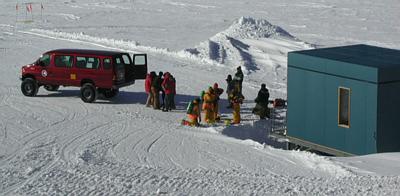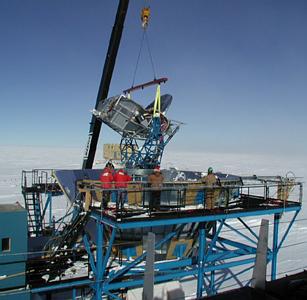
|
|
15 December, 2000
Raising a Telescope and Fire Drill
This afternoon there was great excitement in the dark sector. The optical
system for VIPER, a telescope that will look at the cosmic microwave
background radiation, was being put inside of its shielding today. The
shielding is a set of mirrors that prevents the telescope from seeing the
radiation from the ground.
As VIPER was being harnessed to the crane, Chris Martin and I were in
AST/RO, poking our heads out occasionally to see how close they were to
lifting the telescope. Suddenly the loudspeaker which sends out
station-wide announcements came to life with a loud “WHOOOOOOP!
WHOOOOOOP! There is a fire alarm in the dark sector. The fire alarm in
the dark sector power substation has been activated. Those of you not on
the fire team, please muster in the gym. The fire alarm in the dark
sector power substation has been activated. Anyone not on the fire team
please muster in the gym.” Chris, being on the fire team, grabbed his
parka and was out the door in seconds. I took more time to get my parka
on, which was long enough to hear the second announcement a minute later:
“This is a fire drill. Those of you not on the fire team may stand down.”
So, I went outside to see what was happening with VIPER and the fire
drill. The dark sector power substation is right next to where VIPER was
being moved from. I stood on the roof of MAPO and watched VIPER being
attached to the crane, while the fire team had their drill next door.
A fire at the South Pole could be disastrous. Since the air is so dry,
and many buildings (parcticularly in the dome) are made of wood, any fire
that starts needs to be contained as quickly as possible so that it
doesn’t spread to the rest of the station. If the fire is bad enough, the
station may become inoperable for a while and people evacuated. It would
take a few hours at least for any aircraft to fly to the South Pole from
McMurdo, and if the weather is bad or there aren’t any planes available,
it could be a little while before people could leave. During the winter
months, of course, planes are incapable of flying to the pole, even in an
extreme emergency. If there is a severe fire on the station during the
winter, then there are emergency supplies so that the winterover crew
could survive. However, in such a case much if not all of the scientific
research and new station construction would need to stop for the rest of
the season in order to conserve supplies, even in those areas not affected
by the fire.
The fire team is grouped into two teams. The first team, the team Chris
is on, is the first to arrive at the fire location. They get there as
fast as they can, and if the fire is manageable, put it out: they are the
first response. Getting a fire out as quickly as possible is paramount to
prevent it from spreading. While the first team is running to the fire,
the second team puts on bunker gear. When they arrive at the fire, the
first team yields to them. The second team is equipped to handle a fire
that is larger than is reasonable for the first team to extinguish. In
their gear, they can enter a burning building to get to the fire and put
it out before it spreads any further.
It was interesting being able to watch a fire drill. The first team
showed up very quickly, arriving on foot, bicycle, and shuttlevan. Within
a few minutes, people in bunker gear began to show up. It was amusing to
see guys wearing yellow jackets and green tanks on their back riding a
snowmobile across the snow to the power substation. During today’s drill,
some of the first team were “injured” (that is, if this had been a real
fire, they would have actually been hurt). Other team members had an
emergency medical kit out, and were putting someone on a stretcher and
into the shuttlevan while the second team entered the building. After the
injury was dealt with and the second team was done checking inside, the
team gathered to discuss the drill.
A few minutes after the fire team left, VIPER’s 10,000 pound optical
system including a 2.1m primary mirror was raised and placed into its new
home. In a few weeks, ACBAR, the receiver for VIPER, will be installed in
the telescope. In the mean time, the optics will be tested and adjusted
so that they are directing light from a known point in the sky to the
place where ACBAR will be located. Once ACBAR is installed, the entire
system will be tested, and the telescope will be able to begin collecting
data.

This is the optics for VIPER, still in its tent. Behind it, the small silver building on the right is AST/RO. MAPO, the other main building in the dark sector is the blue building just visible above the tent to the left. The smaller blue building immediately to the left is part of the building that VIPER will be lifted onto.

Here VIPER is being attached to the crane that will lift it to its permanent home. On the left is the dark sector power substation, and the fire team outside.

This is a close up of the fire team. The group on the right is taking care of an injured person, and the team on the left is preparing to enter the building.

While the injured person is being lifted into the shuttlevan, the group in bunker gear enters the building.

After the fire drill was done, VIPER was lifted. Here is a picture of the VIPER optical system, where you can see the 2.1 m primary mirror on the right. The piece being lifted weighs about 10,000 pounds.

Here is VIPER above the shielding where it will be placed. The building in the background is the new dark sector building, where new astronomy projects will be housed.

This is VIPER just above the shielding. When it is in place, the optical system will be completely inside the shielding, so that it cannot see radiation from the ground.
Contact the TEA in the field at
.
If you cannot connect through your browser, copy the
TEA's e-mail address in the "To:" line of
your favorite e-mail package.
|
